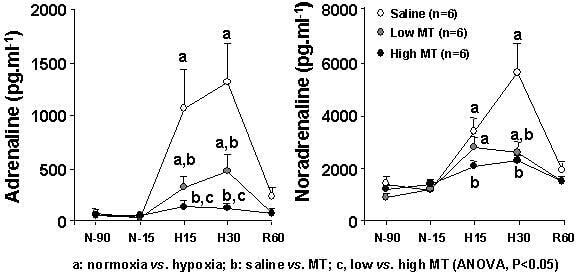The actions of melatonin on fetal physiology have mostly been investigated at the level of the suprachiasmatic nucleus in relation to circadian rhythmicity (Serón-Ferre et al. 2003). However, the presence of melatonin receptors in diverse fetal tissues including the brain and adrenal gland suggest that melatonin may be involved in a wider array of fetal functions. Recent studies have reported that fetal exposure to elevated concentrations of melatonin suppresses stimulated adrenocortical function (Torres-Farfán et al. 2003). However, the effects of melatonin on the sympatho-adrenomedullary axis in the fetus remain unknown. This study investigated the effects of fetal treatment with low and high doses of melatonin on the plasma catecholamine response to acute hypoxaemia in fetal sheep. Under halothane, 6 fetal sheep at 0.8 of gestation were chronically catheterised. Five days later all animals were subjected to 1.5 h of normoxia, 0.5 h of hypoxaemia and 1 h of recovery either during fetal i.v. infusion with saline (vehicle) or during fetal i.v. treatment with low (0.15 mg.min-1) or high (1.5 mg.min-1) melatonin. The doses of melatonin were designed to mimic circulating concentrations of melatonin in the ovine fetus measured at night (low dose; Yellon & Longo, 1988) or that which may result in the human fetus following typical therapy to avoid jet lag in travelling prospective mothers (high dose; Okatami et al. 1998). Fetal arterial blood samples were taken during normoxia, hypoxia and recovery for measurement of blood gases and plasma concentrations of catecholamines by HPLC. At the end of the experiment, animals were humanely killed with pentobarbitone (200 mg kg-1 i.v.). All values are means ± S.E.M.; a two-way RM ANOVA with post hoc Tukey’s test was used. Fetal treatment with melatonin did not alter basal blood gases or plasma catecholamine concentrations. In hypoxaemia, a similar fall in fetal PaO2 occurred during saline (20.8±0.4 to 10.7±0.6), low (20.5±0.6 to 11.0±0.3) or high (21.2±0.5 to 11.2±0.3 mmHg) melatonin treatment. Melatonin markedly suppressed the plasma concentrations of adrenaline and noradrenaline during hypoxaemia in a dose-dependent manner (Figure). These data show that fetal treatment with melatonin markedly suppresses the fetal plasma catecholamine response to acute hypoxaemia.
King's College London (2005) J Physiol 565P, C152
Communications: Melatonin inhibits the sympatho-adrenomedullary response to acute hypoxaemia in the late gestation ovine fetus
Thakor, Avnesh S; Bloomfield, Malcom R; Giussani, Dino A;
1. Physiology, University of Cambridge, Cambridge, United Kingdom.
View other abstracts by:
Where applicable, experiments conform with Society ethical requirements.

